Mass spectrometry analysis of HIV-1 Vif reveals an increase in ordered structure upon oligomerization in regions necessary for viral infectivity
- PMID: 17598142
- PMCID: PMC3366188
- DOI: 10.1002/prot.21471
Mass spectrometry analysis of HIV-1 Vif reveals an increase in ordered structure upon oligomerization in regions necessary for viral infectivity
Abstract
HIV-1 Vif, an accessory protein in the viral genome, performs an important role in viral pathogenesis by facilitating the degradation of APOBEC3G, an endogenous cellular inhibitor of HIV-1 replication. In this study, intrinsically disordered regions are predicted in HIV-1 Vif using sequence-based algorithms. Intrinsic disorder may explain why traditional structure determination of HIV-1 Vif has been elusive, making structure-based drug design impossible. To characterize HIV-1 Vif's structural topology and to map the domains involved in oligomerization we used chemical cross-linking, proteolysis, and mass spectrometry. Cross-linking showed evidence of monomer, dimer, and trimer species via denaturing gel analysis and an additional tetramer via western blot analysis. We identified 47 unique linear peptides and 24 (13 intramolecular; 11 intermolecular) noncontiguous, cross-linked peptides, among the noncross-linked monomer, cross-linked monomer, cross-linked dimer, and cross-linked trimer samples. Almost complete peptide coverage of the N-terminus is observed in all samples analyzed, however reduced peptide coverage in the C-terminal region is observed in the dimer and trimer samples. These differences in peptide coverage or "protections" between dimer and trimer indicate specific differences in packing between the two oligomeric forms. Intramolecular cross-links within the monomer suggest that the N-terminus is likely folded into a compact domain, while the C-terminus remains intrinsically disordered. Upon oligomerization, as evidenced by the intermolecular cross-links, the C-terminus of one Vif protein becomes ordered by wrapping back on the N-terminal domain of another. In addition, the majority of the intramolecular cross-links map to regions that have been previously reported to be necessary for viral infectivity. Thus, this data suggests HIV-1 Vif is in a dynamic equilibrium between the various oligomers potentially allowing it to interact with other binding partners.
(c) 2007 Wiley-Liss, Inc.
Figures










References
-
- Baraz L, Kotler M. The Vif protein of human immunodeficiency virus type 1 (HIV-1): enigmas and solutions. Current Medical Chemistry. 2004;11:221–231. - PubMed
-
- Lake J-a, Carr J, Feng F, Mundy L, et al. The role of Vif during HIV-1 infection: interaction with novel host cellular factors. Journal of Clinical Virology. 2003;26:143–152. - PubMed
-
- Navarro F, Landau NR. Recent insights into HIV-1 Vif. Current Opinion in Immunology. 2004;16:477–482. - PubMed
-
- Rose KM, Marin M, Kozak SL, Kabat D. The viral Infectivity factor (Vif) of HIV-1 unveiled. TRENDS in Molecular Medicine. 2004;10(6):291–297. - PubMed
Publication types
MeSH terms
Substances
Grants and funding
LinkOut - more resources
Full Text Sources

